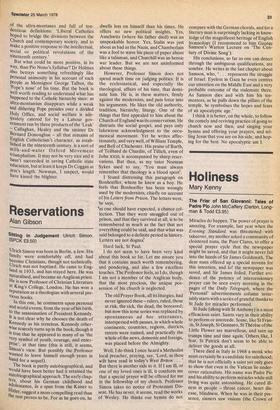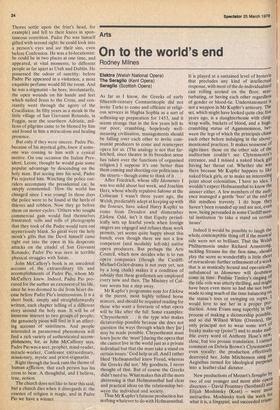Holiness
Mary Kenny
The Friar of San Giovanni: Tales of Padre Pio John McCaffery (Darton, Longman & Todd £3.95) Miracles do happen. The power of prayer is amazing. For example, last year when the Evening Standard was threatened with takeover, my mother asked a community of cloistered nuns, the Poor Clares, to offer a special prayer cycle that the newspaper might be saved, and that it might never fall into the hands of Sir James Goldsmith. The dear nuns offered up a special novena for this intention, and lo1 the newspaper was saved, and Sir James foiled. Further evidence of the potency of intercessionary prayer can be seen every morning in the pages of the Daily Telegraph, where the `Personal' advertisements .column invariably starts with a series of grateful thanks to St Jude for miracles performed.
St Jude (along with St Anthony) is a most efficacious saint. Saints vary in their ability to perform or intercede. Some, like St Fran:is, St Joseph, St Gennaro, St Therase of the Little Flower are marvellous, and turn up trumps time and time again. Otherklike, I fear, St Patrick don't seem to be able to deliver the goods at all.
There died in Italy in 1968 a monk who must certainly be a candidate for sainthood; that he is not officially a saint yet only goes to show that even in the Vatican lie undercover rationalists. His name was Padre Pio and his ability to perform miracles while still living was quite astonishing. He cured illness in people — throat cancer, heart disease, blindness. When he was in their presence, sinners saw visions (the Crown of
Thorns settle upon the friar's head, for example) and fell to their knees in spontaneous contrition. Padre Pio was himself gifted with second sight: he could look into a person's eyes and see their sins, even before Confession. He was a bi-locationist: he could be in two places at one time, and appeared, at vital moments, to different people as far apart as Utah and Dublin. He possessed the odour of sanctity: before Padre Pio appeared in a visitation, a most exquisite perfume would fill the room. And he was a stigmatist — he bore, involuntarily, the open wounds on his hands and feet
• which nailed Jesus to the Cross, and constantly went through the agony of the Crucifixion. In fifty years as a monk in the little village of San Giovanni Rotundo, in Foggia, near the sourthern Adriatic, millions of pilgrims came to be blessed by him and found in him a miraculous and healing presence.
But only if they were sincere. Padre Pio, because of his mystical gifts, knew if someone was coming to him with a cynical motive. On one occasion the Italian President, Leone, thought he would gain some popular advantage by descending on the holy man. But seeing into his soul, Padre Pio rejected him. Watching the police outriders accompany the presidential car, he simply commented: 'How the world has changed since I was young! In those days the police were to be found at the heels of thieves and robbers. Now they go before them on motor-cycles. 'Others who sought commercial gain would find themselves frustrated: rolls and rolls of photographs that they took of the Padre would turn out mysteriously blank. So great were the holy monk's gifts that the Devil himself came right out into the open in his desperate attacks on the citadel of San Giovanni Rotundo; Padre Pio was seen in terrible physical struggles with Satan.
John McCaffery's book is an anecdotal account of the extraordinary life and accomplishments of Padre Pio, whom Mr McCaffery knew. Indeed, Padre Pio procured for the author an extension of his life, since he was doomed to die from heart disease before Padre Pio's intercessions. It is a short book, simply and straightforwardly written, each chapter telling of a different story around the holy man. It will be of immense interest to two groups of people; the genuinely pious will find in it an affecting account of saintliness. And people interested in paranormal phenomena will find a rich variety of authenticated accomplishments, for, as John McCafferey says, Padre Pio was a seer, prophet, mind-reader, miracle-worker, Confessor extraordinary, missionary, mystic and priest-stigmatist.
Right through the book runs the theme of human affliction; that each person has 'rim cross to bear. A thoughtful, and I believe, true, notion.
The church does not like to hear this said, but a church dies when it disregards it: the essence of religion is magic, and in Padre Pio we have a winner.



































 Previous page
Previous page